by guest blogger Beth Terry
I’ve been dedicated to living a life plastic free, and experimenting this summer with starting up a garden. This post is one of many in a series describing my successes and struggles keeping plastic out of my garden.
(If you’re new to this series, check out my first three posts about buying soil, planting and mulching, and watering without plastic. And check out my blog My Plastic-free Life, to understand the problems with plastic and to find plastic-free alternatives.)
POWDERY MILDEW
My squash plants, which started out strong, have developed a host of problems, the first of which is powdery mildew.
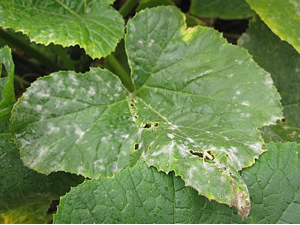 A little online research turned up multiple recipes for controlling powdery mildew with a solution of baking soda, dish soap, and water. A few of them suggested adding some oil as well. I dug out an old spray bottle, filled it with water, and added a tablespoon of baking soda, a tablespoon of vegetable oil (from a glass bottle), and a teaspoon of liquid soap. Well, my own homemade liquid soap that I created from a bar of solid soap. Liquid soap, after all, comes in new plastic.
A little online research turned up multiple recipes for controlling powdery mildew with a solution of baking soda, dish soap, and water. A few of them suggested adding some oil as well. I dug out an old spray bottle, filled it with water, and added a tablespoon of baking soda, a tablespoon of vegetable oil (from a glass bottle), and a teaspoon of liquid soap. Well, my own homemade liquid soap that I created from a bar of solid soap. Liquid soap, after all, comes in new plastic.
So did it work? I’m not really sure. Baking soda is not supposed to “cure” powdery mildew, but to prevent it from spreading. Before I could find out whether this solution was really working, I ended up with other squash problems.
BLOSSOM END ROT, YELLOW LEAVES, AND OTHER MYSTERIES
A month ago, I harvested a couple of beautiful zucchinis and a yellow squash. Since then, my squashes have been withering and dying, with signs of blossom end rot—rot that begins at the blossom end of the squash and works its way up.
What’s more, my cucumbers have simply not thrived. They grow a few beautiful green leaves, then turn yellow, then brown, then die.
Same with my wax beans. The plants just turn yellow. Then brown. Then keel over and die.
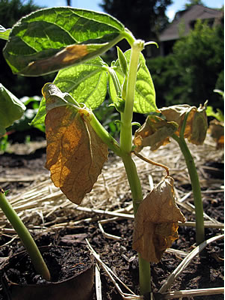 With all these woes, Eric suggested I get my soil tested. Yes, testing my brand new soil. So I sent a sample to a lab (in a plastic bag). And what I found is that a) the soil is very alkaline, and b) it’s extremely low in calcium, even though it’s high in everything else. Weird. Blossom end rot is definitely a symptom of calcium deficiency. I don’t know if lack of calcium is causing the other problems or not. I’m also wondering if I’m watering too little or too much.
With all these woes, Eric suggested I get my soil tested. Yes, testing my brand new soil. So I sent a sample to a lab (in a plastic bag). And what I found is that a) the soil is very alkaline, and b) it’s extremely low in calcium, even though it’s high in everything else. Weird. Blossom end rot is definitely a symptom of calcium deficiency. I don’t know if lack of calcium is causing the other problems or not. I’m also wondering if I’m watering too little or too much.
ADDING CALCIUM WITHOUT INCREASING PH
There are various ways to add calcium to soil. I decided to try gypsum, which is calcium sulfate, because it’s not supposed to raise the pH of your soil the way lime will, and it’s a source of sulfur. Plus, it came in a paper bag. Or so I thought…
Once I tore open the bag, I discovered the plastic layer inside.
Ah, well.
I’m not sure if the gypsum is helping, and I’m not sure if I should be watering more or watering less. As I said, the weather in Oakland has been crazy. While the rest of the country is dealing with record high temperatures, we are freezing here. Don’t even ask about my peppers. They’re not worth mentioning.
For now, I’m just going to enjoy my chard, watch my tomato plants fill up slowly with fruit, and hope my one remaining bean plant survives. It’s got two little beans on it, but the leaves look pretty yellow. Want to place your bets?

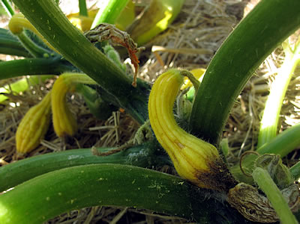
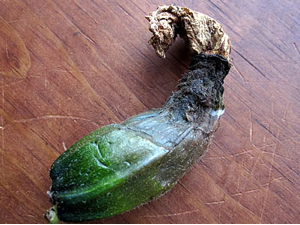
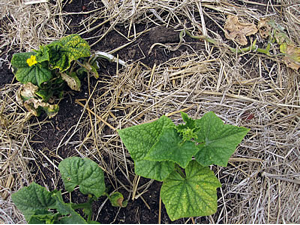




Beth, I feel for you. I have often had the same problems with my squash. I have used milk mixed with water in a spray bottle with some success in years past. The problem is that you have to keep spraying the plants.
I wonder if you have seen the article, “The Myth of Gypsum” — interesting reading. This year I used some peat in my clay soil to loosen it and provide greater drainage. I wasn’t keen on peat as it is really a non-sustainable product — and is harming peat bogs around the world — but I thought it was my best “organic” option — short of organic leaf mulch or organic compost.
If you think of the chemicals involved in producing any animal manure — as well as the pesticides in growing mushrooms — you really need to be careful when adding amendments to soil. Thanks for your article. I enjoyed reading it.
Gypsum does not improve clay soil. This is a famously popular myth. Baking soda does very little to control fungus. Research has found it to be ineffective. Read Jeff Tillman’s books to get the truth about organic gardening.
Your squash look exatally like ours when we haven’t hand pollenated. You could have a lack of pollenation. Feel free to pick the male blossoms as they don’t produce fruit anyway. Remove the pettels and rub the pollen on the female blossoms.
My cukes didn’t make it this year either. My tomatoes started out with early blight, but I nipped it in the bud. I sprayed them with a organic solution of sodium bicarbonate and potassium bicarbonate. They are rebounding well. I also had an attack of tomato hornworms. I look every day, twice a day, for evidence of them, this way I can find them and pick them off the vines before they get a hold and really do damage. I am finally getting some tomatoes. The hornworms seem to like my Brandywines and Black Krims better than other plants. Go figure!
I stripped my trellises of the cukes and chalked it up to experience for the year. I’m readying myself to start planting cool weather veggies, that’s if the stink bugs doesn’t destroy them!! I hear that they are really wreaking havoc in the southern states, causing much crop damage.
It’s always a struggle against nature. It seems to have gotten worse over the years. Good luck with the rest of the gardening season everyone.
Would crushed eggshells return any calcium to the soil?
I feel your pain. This year is a loss in the vegetable garden – just too hot. Oh, the love of gardening and the disappointments, how they go hand in hand.